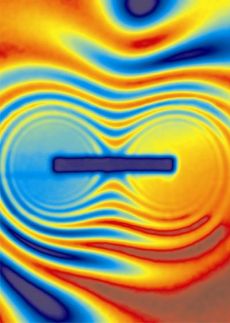Scientists discover repulsive side to light force
A team of Yale University researchers has discovered a "repulsive" light force that can be used to control components on silicon microchips, meaning future nanodevices could be controlled by light rather than electricity.
The team previously discovered an "attractive" force of light and showed how it could be manipulated to move components in semiconducting micro- and nano-electrical systems - tiny mechanical switches on a chip. The scientists have now uncovered a complementary repulsive force. Researchers had theorized the existence of both the attractive and repulsive forces since 2005, but the latter had remained unproven until now. The team, led by Hong Tang, assistant professor at Yale's School of Engineering & Applied Science, reports its findings in the July 13 edition of Nature Photonics's advanced online publication.
"This completes the picture," Tang said. "We've shown that this is indeed a bipolar light force with both an attractive and repulsive component."
The attractive and repulsive light forces Tang's team discovered are separate from the force created by light's radiation pressure, which pushes against an object as light shines on it. Instead, they push out or pull in sideways from the direction the light travels.
Previously, the engineers used the attractive force they discovered to move components on the silicon chip in one direction, such as pulling on a nanoscale switch to open it, but were unable to push it in the opposite direction.
Using both forces means they can now have complete control and can manipulate components in both directions. "We've demonstrated that these are tunable forces we can engineer," Tang said.
In order to create the repulsive force, or the "push," on a silicon chip, the team split a beam of infrared light into two separate beams and forced each one to travel a different length of silicon nanowire, called a waveguide. As a result, the two light beams became out of phase with one another, creating a repulsive force with an intensity that can be controlled - the more out of phase the two light beams, the stronger the force.
"We can control how the light beams interact," said Mo Li, a postdoctoral associate in electrical engineering at Yale and lead author of the paper. "This is not possible in free space - it is only possible when light is confined in the nanoscale waveguides that are placed so close to each other on the chip."
"The light force is intriguing because it works in the opposite way as charged objects," said Wolfram Pernice, another postdoctoral fellow in Tang's group. "Opposite charges attract each other, whereas out-of-phase light beams repel each other in this case."
These light forces may one day control telecommunications devices that would require far less power but would be much faster than today's conventional counterparts, Tang said. An added benefit of using light rather than electricity is that it can be routed through a circuit with almost no interference in signal, and it eliminates the need to lay down large numbers of electrical wires.
Most read news
Other news from the department science

Get the chemical industry in your inbox
By submitting this form you agree that LUMITOS AG will send you the newsletter(s) selected above by email. Your data will not be passed on to third parties. Your data will be stored and processed in accordance with our data protection regulations. LUMITOS may contact you by email for the purpose of advertising or market and opinion surveys. You can revoke your consent at any time without giving reasons to LUMITOS AG, Ernst-Augustin-Str. 2, 12489 Berlin, Germany or by e-mail at revoke@lumitos.com with effect for the future. In addition, each email contains a link to unsubscribe from the corresponding newsletter.





























































